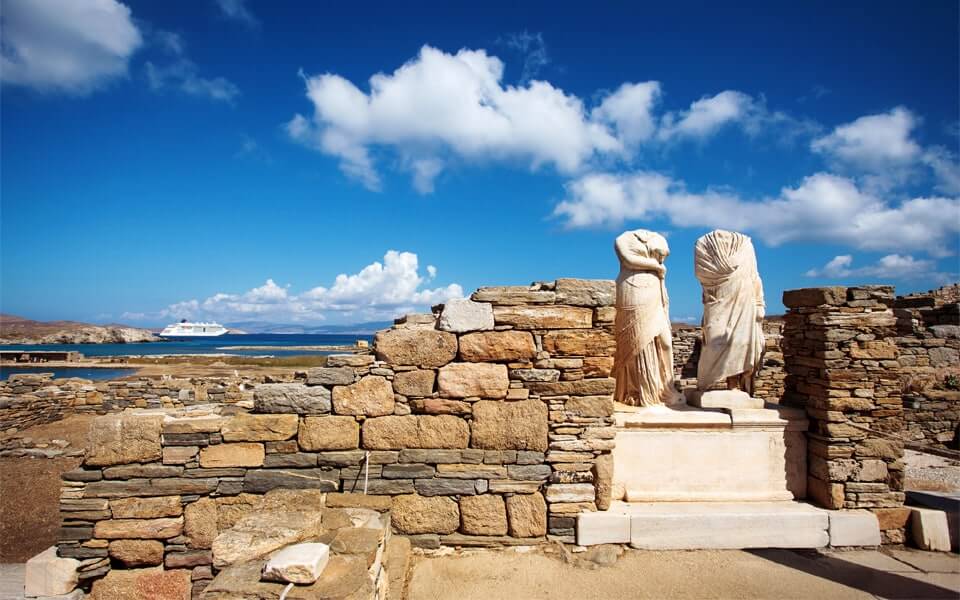Not only is Delos island the heart of the Cyclades archipelago, but it is also one of the most powerful energetic spots in the Mediterranean. Its allure and attraction are undeniable among lovers of sites with supreme archaeological, historical, and mythological value tied to them.
What is Delos? Delos had, in fact, a leading role in the ancient Greek world (and not only) as a holy sanctuary and a cult center for hundreds of years before it became the mythological birthplace of the Olympian Greek Gods of Artemis and Apollo. Even if you just want to enjoy heart-stopping sunset views and a unique sense of tranquility and peacefulness, Delos Island Greece, is still a place to explore.

Becoming a Holy Sanctuary
Inscribed as a UNESCO World Heritage Site in 1990, Delos had undergone several “purifications” in the past by the then city-state of Athens, in an attempt to cleanse the island and render it fit for the worship of the Olympian Gods. The first purification dates back to the 6th century BC when tyrant Pisistratus had all the graves around the temple moved to another island.
A century later, all dead bodies were removed from the island under the instructions of the Delphic Oracle, the members of which also ordered that nobody was allowed to either give birth or die on the sacred lands of Delos. In the next four years, the island’s purification was completed by forcing its inhabitants to find a new homeland in Asia.
From that point onward, the island became the host of the infamous Delos Mysteries, initiations where religious practices were performed, which were quite similar to the Eleusinian Mysteries.
To date, the energy that Delos continues to exude entices those on a spiritual journey, who make it their life’s purpose to step foot on the island, at least once in their lifetime. So, don’t be surprised if you notice people meditating and practicing yoga or other spiritual and mental practices.
What to see in Delos Island
The circular bowl that once hosted the Sacred Lake (now left dry intentionally to prevent the spread of disease-causing bacteria), as well as the sacred spring known as the Minoan Fountain, are must-see attractions.
Other than that, you will also have the chance to lay eyes on several ancient Greek market squares and, of course, the Temple of the Delians, which is dedicated to the worship of Apollo. The parts that you will see remaining extant beside the temple once composed a gigantic 6th-century statue of the god.
As for the widely popular Terrace of the Lions, it used to have between nine and twelve lions made from the finest marble in the Cyclades, which guarded the Sacred Way, bearing resemblances with the Egyptian sacred place of Karnak.
Don’t forget to visit the Doric temple of Isis, which provides not only archaeological interest but also incredible views of the shimmering Aegean Sea, along with the Temple of Hera, which dates back to 500 BCE.
To get a glimpse of the luxury that defined the 2nd century, head to the House of Dionysus – the mosaic floors are indeed striking. Speaking of awe-inspiring mosaic, the House of the Dolphins also houses atrium mosaic, depicting God Eros riding dolphins.
And, if you are wondering about the three conical mounds that can be seen from the Sacred Harbour, they are crowned with various sanctuaries, including one of Zeus. Today, many of the Delos artifacts are on display at both the Delos Archaeological Museum and the Athens Archaeological Museum.
For those interested in archaeological site of Delos, exploring these remnants of a once-thriving civilization will be an unforgettable experience.
How to Visit Delos Island
Delos is easily accessible via boat tours from Mykonos, making it a convenient day trip for visitors. Whether you’re drawn by the rich history, stunning ruins, or spiritual energy of Delos Island, a visit here promises a unique journey through time.